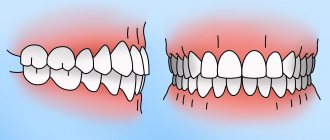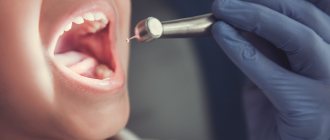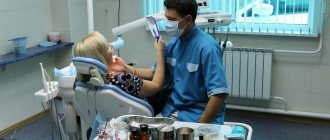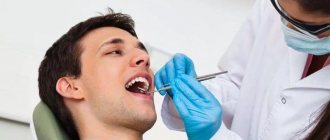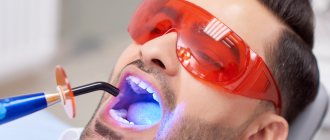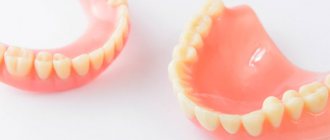Author of the article: Kryukov Andrey Vladimirovich
Chief physician. Doctor-expert
Specialization: Dentist-orthopedist
Total work experience: since 2005
Reading time: 7-8 minutes
Orthopedics in dentistry is a branch of medicine that deals with the restoration of teeth using all modern prosthetic techniques. It is not surprising that an orthopedic dentist is popularly known as a prosthetist. To preserve decaying teeth or restore the attractiveness of your smile, it is important to know with what symptoms you need to go to this specialist, what methods he uses and what results he guarantees.
Problems solved by orthopedic dentistry
To understand who an orthopedic dentist is, you need to know more about the field of medicine in which this doctor works. The main tasks that orthopedic dentistry solves are:
- restoration of dentition;
- elimination of chewing function disorders;
- installation of prostheses, as well as regulating and replacement devices;
- diagnosis, prevention and treatment of speech apparatus deficiencies;
- therapy of jaw diseases using specialized devices and structures.
The efforts of specialists working in this field are aimed at eliminating most defects in the dentition and achieving maximum aesthetics of the result (taking into account the functional component).
iOrtho Blog
Why do chipped teeth occur and how to get rid of them?
Ligature braces: types and application features
Types of mouth guards for bruxism and features of their use
Billie Eilish, Grammy and Invisalign
Pain during tooth extraction: why and how long does it hurt?
Molars and premolars: main differences and features
Plates for dentition correction: features and effectiveness of use
Tooth erosion: what is it and how to treat it?
Symptoms for which people consult an orthopedic dentist
Consultation with a specialist is necessary if the following symptoms are present:
- absence of any number of teeth in a row (as a result of planned removal, loss, after injury, etc.);
- partial or almost complete destruction of the enamel and walls of the tooth;
- diagnosed diseases of the gums or jaw bones;
- increased (and in some cases painful) tooth sensitivity;
- various types of TMJ disease (temporomandibular joint);
- cosmetic defects (in particular, irregular shape, pigmentation and other disorders that spoil the aesthetics of the smile).
A dental therapist or other highly specialized specialist can diagnose problems that should be addressed specifically by an orthopedic dentist after an initial examination and consultation.
In conclusion
Many people believe that installing implants is harmful to the body, since serious complications are possible. However, we should not forget that the absence of teeth also negatively affects health, since in addition to aesthetics (smile), a person’s teeth also perform a certain function (chewing food). The absence of certain teeth leads to a decrease in self-esteem, which affects a person’s psycho-emotional state, as well as problems with the gastrointestinal tract, since food is not chewed thoroughly enough.
You should not delay your visit to the doctor, assuming that implantation will cost too much or that it is not necessary. Of course, this is not a cheap service, but the result is worth the money spent.
What does an orthopedic dentist treat?
What a prosthetist does cannot be 100% called treatment in the usual sense of the word. Rather, it resolves issues that are not amenable to therapeutic treatment. For example, you may be referred to an orthopedic dentist if you need:
- Restoration of chewing function.
Gaps in the dentition do not allow chewing food with the necessary thoroughness, which has a detrimental effect on the functioning of the digestive system. The absence of one or more teeth in a row can lead to the appearance of chewing dysfunction, which disrupts the functioning of the dental system as a whole. In addition, muscle tone decreases and blood circulation slows down not only in soft tissues, but also in bone tissues. Ignoring the problem will inevitably lead to complications, in particular to periodontitis or periodontal disease. Thus, solving the issue of restoring the integrity of the dentition will help not only restore chewing functions, but also improve overall health. - Preservation of teeth
. If a tooth is not lost, but is significantly damaged, this is not yet a reason to remove it (even if the possibility of installing a filling is excluded to solve the problem). Thanks to the achievements of modern dentistry, doctors have the opportunity to preserve healthy roots and nerve endings, stop advanced caries and restore/restore the tooth. - Treatment of adentia
. Only an orthopedic dentist can help patients with partial or complete absence of teeth. In this case, based on the individual characteristics of the patient and the tasks assigned to him, the specialist will propose and install removable, conditionally removable or fixed dentures, implants or other techniques that can restore the integrity of the dentition.
The solution to the problem on the listed points is individual for each individual patient. Only a consultation and initial examination will allow us to predict and approve the treatment plan and all the nuances.
Most often, an orthopedic dentist is consulted for:
- restoration of bone tissue and enamel in order to preserve living natural roots and nerve canals;
- installing protective crowns on a tooth that is not subject to aesthetic restoration;
- individual production and installation of various types of prostheses;
- elimination of purely aesthetic defects (chips, uneven teeth, correction of enamel color, etc.).
It is mistakenly believed that the services of a prosthetist are required mainly by older patients. Modern dentistry is ready to offer effective solutions in the field of restoration and prosthetics for people of all ages, including children who have dental problems.
Which dental prosthetics should you choose?
The choice of dental prosthetics method depends on the specific situation, the condition of the oral cavity, physiological characteristics, individual preferences and financial capabilities. If the teeth have external defects, but healthy roots, then it is possible to install veneers or crowns.
If 1-2 teeth are lost, they can be restored with a bridge or implants. If most of the dentition is lost (or cannot be restored), then there are 2 main options - acrylic removable dentures or complete dentures on implants using the All-on-4 system (i.e. “all on four”) or All-on -6 (i.e. “all on six”).
Techniques used by an orthopedic dentist
Already knowing what an orthopedic dentist treats, it’s time to understand what techniques he uses to achieve his goals. Today there are three of them:
- Microprosthetics
. Suitable for cases where the patient has only cosmetic defects and there is a high degree of preservation of the tooth (only the upper part is damaged). To implement microprosthetics, the following are used:- Veneers
. Designed to adjust the appearance of the tooth in color and shape. Ideally mask enamel defects and slight curvature. They are thin plates that are attached to the front of the teeth using special glue. The average service life is about 10 years. - Lumineers
. The design and method of use/installation are similar to veneers, but thinner. Their installation does not require preliminary grinding of all tooth enamel. - Tabs
. Unlike veneers and lumineers, they are used not on the front teeth, but on the chewing teeth. They are visually similar to fillings, but are made not from composite materials, but from ceramics. - Removable prosthetics
. Orthopedic structures for this type of prosthetics are a nylon or plastic base with securely attached artificial teeth. There are two types of such prostheses:- full
(over the entire jaw with complete edentia); - partial
(similar to “bridges”, but they can be removed from the mouth independently). - Fixed prosthetics (permanent)
. This type of prosthetics involves the use of:- Coronok
. Acts as an alternative to filling and artistic restoration. Used in cases of significant tooth decay. They are cap-shaped structures that completely or partially cover the tooth being prosthetized. They are made of metal, metal-ceramics, plastic and a combination of metal and plastic. - Bridge prostheses
. They are used in cases where several teeth in a row are missing in a row. They are structures consisting of two supporting crowns (placed on supporting units) and a “bridge” with artificial teeth located between them. - Implants.
A completely artificial structure, part of which is implanted into the bone tissue of the jaw (over time, complete engraftment/fusion occurs). They consist of artificial roots on which an artificial tooth is placed (screwed).
Such prostheses are attached using clasps (semicircular locks), suction cups, or glue (depending on the type of prosthesis).
Now you know what an orthopedic dentist treats and what modern techniques he uses for this. Don’t aggravate existing dental problems - plan to schedule a consultation with a prosthetist soon to learn more about how exactly your individual issues can be solved.
Possible complications
Dental implants are a foreign material for the body, so the risk of complications can never be excluded. Modern product installation methods and techniques can minimize this risk as much as possible.
Possible complications:
- seam divergence;
- severe pain for more than three days;
- formation of hematomas;
- the appearance of bleeding;
- development of soft tissue inflammation.
Such complications are rather exceptions that arise due to compliance with the doctor’s advice on care during the rehabilitation period.
Somewhat more often, implant rejection and inflammation of the bone and gum tissue near the implant occur. The cause of inflammation can be insufficient oral care or violation of doctor’s recommendations. Implant rejection is an individual reaction of the body. The result is also influenced by which doctor places the dental implants. A qualified specialist will not make mistakes during the operation, and will monitor the patient’s condition throughout the entire rehabilitation in order to take timely measures and prevent complications.
Which colleagues does the prosthetist interact with?
The implementation of any of the techniques used by an orthopedic dentist is impossible without close interaction with other specialists. An integrated approach to restoration and prosthetics is carried out with the contribution of the following doctors to the common cause:
- Dentist-therapist
. Performs preparatory work prior to prosthetics - carries out sanitation of the oral cavity, removes dental deposits (plaque and tartar), and treats diseases of the mucous membrane and periodontium. - Dentist-surgeon
. At the preparation stage, it removes teeth and non-viable roots in cases where the problem cannot be treated therapeutically. At the stage of prosthetics, implants are implanted into the jaw, on which the orthopedist later carries out the final stage of restoration of the dentition. - Dental Technician
. This specialist uses impressions made by an orthopedist to make the necessary prosthetics and orthopedic structures. If necessary, after fitting the patient, he also adjusts the created prostheses, correcting possible shortcomings that cause discomfort to the patient. - Anesthesiologist (or resuscitator)
. Interaction with this colleague is necessary when, with complete edentia, it is necessary to place many implants on both jaws. This procedure may require general rather than local anesthesia. - Dentist-orthodontist
. If prosthetics are to be installed, and the patient has problems with the bite, then the treatment plan includes the need to contact this particular specialist. After complete treatment, you can begin preparing and installing prostheses.
When planning prosthetics, be prepared for the fact that a comprehensive solution to the problem will be required. This means that in addition to the orthopedic dentist, you will have to visit a number of highly specialized specialists.
What techniques do you use to eliminate TMJ dysfunction?
In addition to special equipment, mouth guards and trainers help relieve tension and restore muscle function. That is why specialists prescribe them to patients before or after the installation of orthopedic structures. In addition, trainers and mouthguards also allow you to optimize and shorten the process of orthodontic treatment, especially when it comes to children. Previously, it was believed that a child with a narrow jaw could not avoid crowded teeth. Modern experts have refuted this statement and proved that jaws can “adjust” to any size of teeth, provided that nothing interferes with their growth. However, improper functioning of the muscles can stop the development of the jaws, and they will have to be expanded with the help of braces or complex treatment. A gnathologist helps you tone your muscles in a timely manner and avoid the appearance of serious curvatures. And this applies not only to children, but also to adults, with the only difference being that for the latter, the process of achieving the desired result will take a little longer.
Another way to restore proper muscle function is myogymnastics, a special program that stimulates the formation of a correct bite and its correction, preventing relapses after orthodontic treatment. The specialist will prescribe which exercises you will perform.
How is the diagnosis performed at the initial appointment with an orthopedic dentist?
Modern dentistry allows almost all manipulations to be performed painlessly for the patient. At the same time, some people who have had bad experiences in the past are afraid of visiting clinics. Most often, they prefer to know in advance what a specialist will do in order to mentally prepare not only for the procedures, but also for the initial examination, during which the diagnosis is made. If you are planning to visit a prosthetist for the first time, be prepared for the following stages of interaction:
- Basic: Questioning to collect anamnesis
. Here the specialist asks questions that will help you individually choose a method for solving the problem. - Facial examination
. To study the size of the mouth gap, possible shortening of the lower part of the face and asymmetry, features of the setting of the lips and chin. The tone of the lip muscles is also determined by palpation. - Oral examination
. The bite, shape, size and condition of existing teeth are carefully examined. The condition of the mucous membrane, the individual nuances of the formation of the frenulum of the lips are also assessed, the shape and span of the tongue, the arch of the hard palate and the general development of the jaws are studied. - X-ray
. Radiography allows you to assess the condition of the supporting units, as well as identify the presence of impacted and other special elements that cannot be detected without photographs.
(may be needed for a deeper study and accurate diagnosis):
- functional chewing samples are taken;
Based on the results of the main and additional examination, the specialist makes a diagnosis and develops individual treatment tactics. Knowing who an orthopedic dentist is, in what cases you should contact him and what he will do when you arrive at your appointment, visiting dentistry will not be so scary. And since the initial examination is absolutely painless and without discomfort, it makes sense to at least sign up for a consultation in order to understand the condition of your teeth and whether it is possible to save those about which you have complaints.
Methods for making a crown
Orthodontic products can be manufactured using several methods. Each of them has its own advantages and disadvantages.
Cast products
Strong and durable crowns are made using casting. For this, a single piece of metal is used. The method is not suitable for all materials.
Stamped
More affordable, but less durable prostheses are made by stamping:
- a mold is placed into the dental anvil;
- using rubber rings a stamp is obtained;
- the crown is made using special hammers that differ in shape and size;
- The product is given its final shape using small tongs.
Such crowns last less than cast ones, but are much cheaper to produce.
